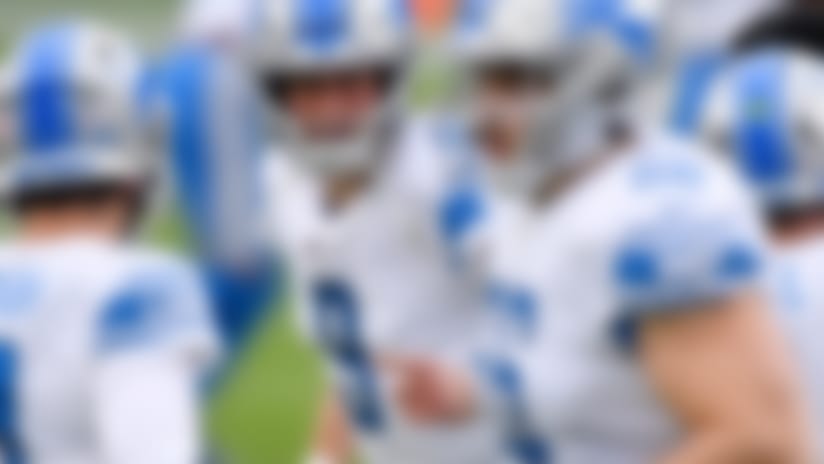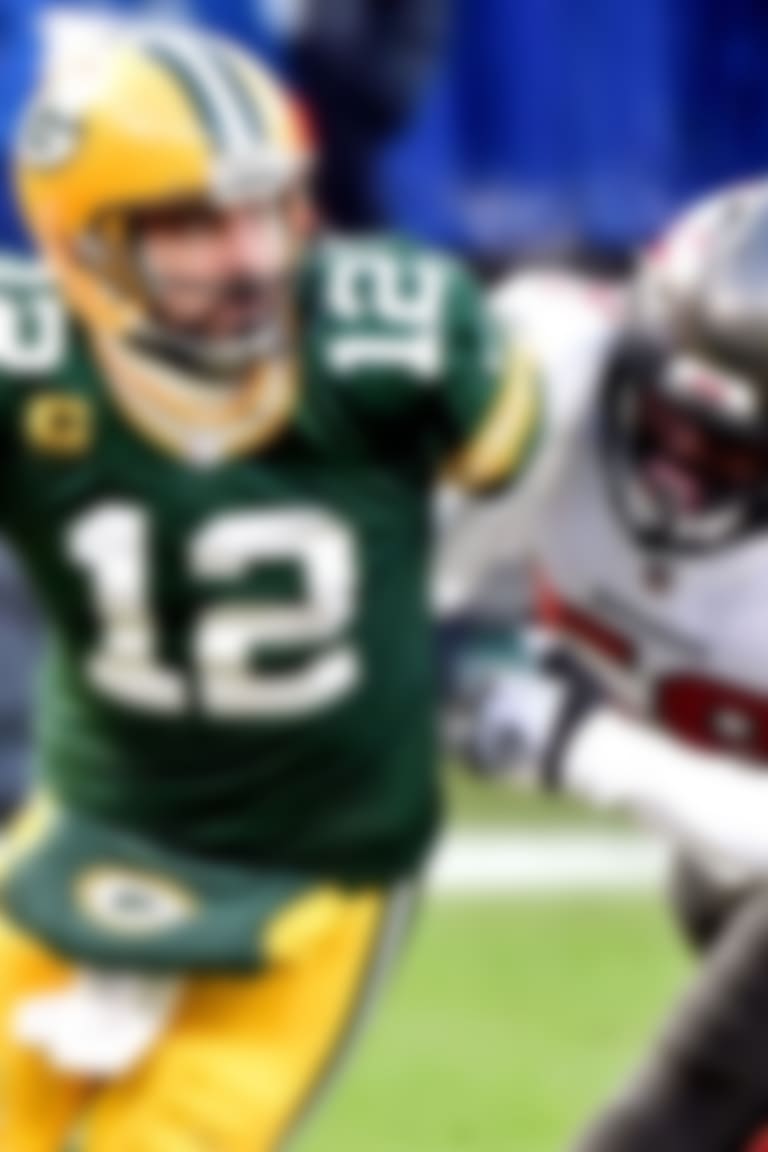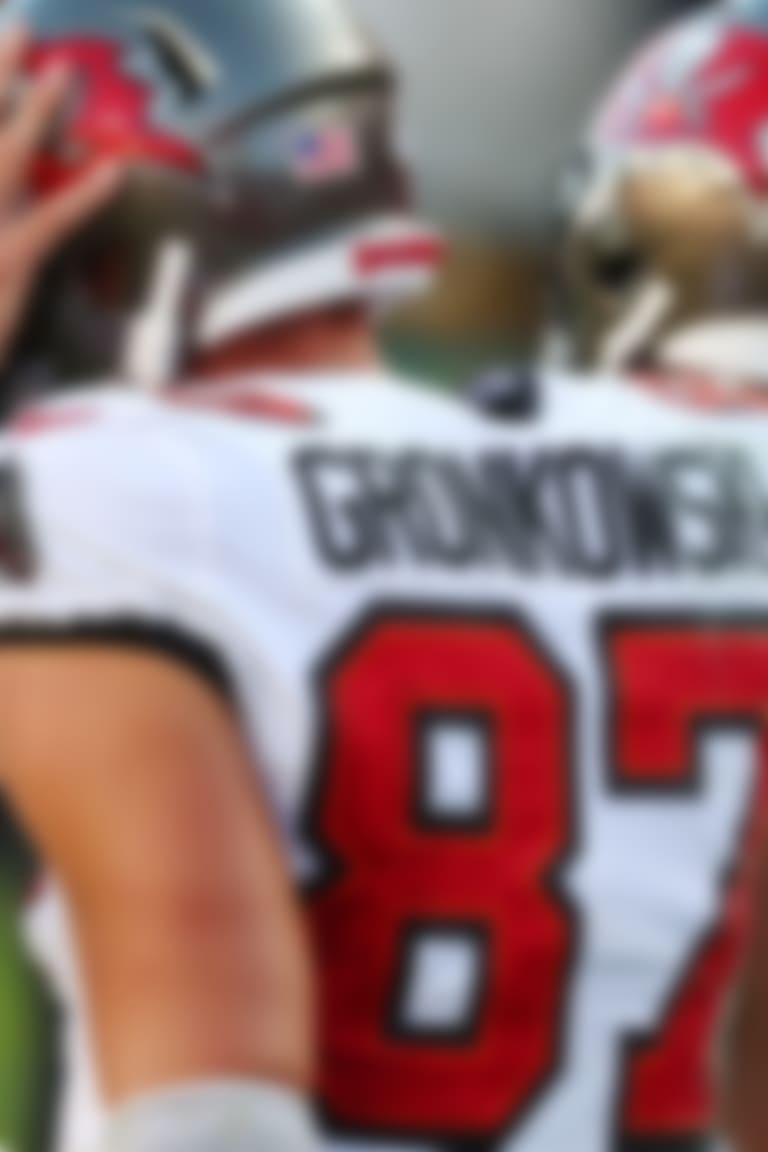Bucs' success of Brady signing has NFL eyeing massive QB movement
Last March, Tampa Bay went all in with the signing of Tom Brady, a get-rich-quick scheme that paid off handsomely. Now, after the Bucs’ success, many in this copycat league are bracing for falling dominos, with unprecedented quarterback movement this offseason.
For Jason Licht, it was almost like an out-of-body experience. There he was, pacing around Bruce Arians’ open-floor-plan kitchen last March 18, talking on his cell phone to Tom Brady — and listening to what amounted to a sales pitch from the most accomplished player in NFL history as to why the free-agent quarterback would be a great addition to the Tampa Bay Buccaneers.
It was just after 4 p.m. ET, the official start of the league year, and Licht, the Bucs’ general manager since 2014, had previously received some very strong signals that Brady hoped to head south to Tampa Bay after 20 insanely successful seasons with the New England Patriots. Getting that message from the great quarterback directly, and hearing the desire to please in his voice, was surreal and somewhat strange. After about 45 minutes, Licht handed the phone to Arians, the authentic and acerbic head coach he’d hired a year before. As Arians walked around the house talking to the living legend who’d soon be in charge of running his offense, Licht smiled at Arians’ wife, Christine, and said, “I think it’s going well!”
When the call ended, Licht and Arians stared silently at one another for a moment.
“Oh my God,” Licht said. “I think this is happening.”
“Hell yeah, baby,” Arians said confidently, and soon the two were sitting outside, six feet apart, at a nearby restaurant hoisting celebratory drinks — Crown Royal for Arians, a Peroni beer for Licht — and wrapping their heads around the fact that Brady would be taking his talents to Tampa.
From a personnel perspective, this was a Jordanesque leap from the free-throw line, but it was hardly a slam dunk: Brady would turn 43 before the start of the regular season, and he’d be learning a new system with new terminology, an endeavor that would become much harder after a global pandemic essentially wiped out the offseason and deep-sixed the preseason schedule. The Bucs were coming off a 7-9 campaign — the 12th consecutive year in which they had failed to make the playoffs — and would have to contend with established NFC powers like the division-rival New Orleans Saints, Green Bay Packers and Seattle Seahawks (all of them led by future Hall of Fame quarterbacks), not to mention the defending conference champion San Francisco 49ers.
Yet Licht, who’d spent seven seasons in the Patriots’ front office during two separate stints that coincided with Brady’s two-decade reign in New England, understood the impact this ruthless and relentless competitor could have on the organization, and the potential reinforcements his presence could attract.
Looking back, Brady’s arrival was everything Licht could have hoped for, and more.
“Relentless is the best word to describe him,” Licht said last week, in a phone interview that took place three days after the Bucs’ 31-26 NFC Championship Game victory over the Green Bay Packers at Lambeau Field. “He’s so detailed; you can’t give him enough information. He knows about every aspect of the operation, and he’s always looking for an edge and a way to make things better. And he raises the bar for everybody.”
As Brady prepares for his 10th Super Bowl in 21 seasons — and attempts to hoist the Lombardi Trophy for the seventh time — he’s rightfully being lauded as a transformative force for a franchise that won its lone championship 18 years ago. On Sunday, the Buccaneers will become the first team to play the NFL’s centerpiece event in their home stadium, as they try to deny Patrick Mahomes and the Kansas City Chiefs a second consecutive title.
It’s a Super Bowl LV matchup for the ages, but the impact of the Brady signing won’t end when the clock hits 0:00.
More than 10 months after that fateful phone conversation in Arians’ kitchen, the Bucs’ seismic signing continues to reverberate across the NFL landscape.
“You always use the history, or the current events, as reference points to try to mimic or emulate teams that have success,” Los Angeles Rams coach Sean McVay said in a phone interview last Thursday as he vacationed in the Cabo San Lucas area of Mexico. “I have so much respect for what Jason and Bruce have done. Looking at the way it played out, you can have a lot of admiration for them having the stones to take that leap.
“You can’t help but be impressed by the leadership and productive play Tom has provided. When there are examples of it working, that gives teams more of an inclination to shoot their shot. It makes you have a mindset of, to quote Bruce Arians, ‘No risk it, no biscuit.’ “
Two days after that interview, McVay agreed to trade starting quarterback Jared Goff — a player who 17 months earlier had signed a four-year, $134-million contract extension in the wake of a stellar 2018 season and Super Bowl LIII appearance — to the Detroit Lions for 12-year veteran quarterback Matthew Stafford, sweetening the deal with two first-round draft picks and a third-round selection. That haul of picks reflected the Lions’ willingness to absorb Goff’s contract, mitigating the Rams’ salary-cap hit and facilitating a switch to a signal-caller whom McVay clearly views as an upgrade.
And though the move can’t become official until March 17 (the start of the 2021 league year), shoot your shot season has clearly commenced, and we’re just getting warmed up.
With Houston Texans star Deshaun Watson having asked the team to trade him, several other established quarterbacks potentially on the market, an intriguing crop of draft-eligible passers and a potential spillover effect that could free up previously entrenched starters if their current teams land more enticing alternatives, a flurry of activity at the sport’s pivotal position looms like never before.
“It’s started out that way, right?” Seahawks general manager John Schneider said, referencing the Stafford/Goff deal. “There’s a lot less patience than there used to be, so I think we’ll see more people moving around.”
One person watching closely is Chicago Bears coach Matt Nagy, whose team is actively seeking a replacement for Mitchell Trubisky, the No. 2 overall pick in the 2017 draft.
“With all these quarterbacks out there, and all those young guys who’ll be in this draft, it’s gonna be a fascinating offseason as far as the quarterback position,” Nagy said. “And once one goes, it’s gonna be like a domino effect.”
Buffalo Bills general manager Brandon Beane, whose team reached the AFC Championship Game behind third-year standout Josh Allen (before falling short against fourth-year superstar Mahomes and the Chiefs), echoed Nagy’s sentiment.
“It’s a quarterback league,” Beane said. “I do think there will be some teams that will be aggressive like Tampa was — teams that conclude, ‘If we can just get a quarterback, we can compete for a championship.’ Tampa hasn’t been in the playoffs since when? You get Tom Brady, and basically swap him out with Jameis (Winston), and all of a sudden look where they are.
“It seems like there’ve been more situations with some real dudes [potentially available] than ever before. Last year had (Philip) Rivers, Brady, Jameis, Cam (Newton) … there were big names, which was so unusual. And this year looks like it’ll be even crazier.”
The craziness began after the Packers’ NFC Championship Game defeat to Brady and the Bucs when Rodgers, in his postgame press conference, spoke of an uncertain future. That unsolicited comment, along with the fact that Green Bay traded up in last April’s draft to select quarterback Jordan Love in the first round, provoked intrigue around the league that the 37-year-old Rodgers — who’ll likely win his third MVP award on Saturday night — might be available. Both Rodgers and the Packers’ powers that be have since tried to squelch that talk, but it likely won’t stop teams from at least inquiring.
Then there’s Watson, 25, already regarded as one of the league’s top quarterbacks and — at least for now — hell-bent on playing for a new team. Newly hired Texans general manager Nick Caserio has said Houston has “zero interest” in trading Watson, but the threat of a protracted standoff, and the emergence of one or more blockbuster offers, could change things.
In the meantime, teams are doing their due diligence on a number of fronts. The Philadelphia Eagles may look to trade Carson Wentz, the No. 2 overall pick (just behind Goff) in the 2016 draft, who lost his starting job to rookie Jalen Hurts last December. Newton, a former league MVP, struggled in his first season with the New England Patriots and will likely hit the open market, though there may not be significant interest in bringing him in as a starter.
Depending upon which teams land some of the bigger names, established starters such as Jimmy Garoppolo (San Francisco), Derek Carr (Las Vegas) and another former league MVP, Matt Ryan (Atlanta), could hit the market. So might recently drafted players like Sam Darnold (New York Jets), the third overall pick in 2018, or Tua Tagovailoa (Miami), who went fifth overall last year. Current starters Teddy Bridgewater (Carolina), Drew Lock (Denver) and Alex Smith (Washington) could also end up elsewhere.
Others whose futures are worth pondering include Winston (a Saints backup in 2020 and potential successor to Brees, who is believed to be retiring), Minnesota Vikings starter Kirk Cousins (a potential 49ers trade target) and Dallas Cowboys starter Dak Prescott, who received the franchise tag last offseason and suffered a season-ending ankle injury in October. Prescott could theoretically be tagged again, but if he and the Cowboys can’t agree on a long-term deal, things could get interesting.
Oh, and five quarterbacks — beginning with Clemson’s Trevor Lawrence, whom the Jacksonville Jaguars are expected to select with the first overall pick — are being talked up as potential first-round selections in this April’s draft. That list includes Justin Fields (Ohio State), Zach Wilson (BYU), Trey Lance (North Dakota State) and Mac Jones (Alabama).
Granted, some of these quarterbacks aren’t regarded as being even close to Brady’s caliber. Yet in the wake of the Bucs’ big gamble — and Licht’s accompanying aggressiveness in acquiring established veteran weapons (running backs Leonard Fournette and LeSean McCoy, wide receiver Antonio Brown and tight end Rob Gronkowski) — there are likely to be more teams looking for a similar payoff by shaking it up at the most important position.
“Teams are seeing quarterbacks increasingly as commodities, like any other position, rather than as sacred cows,” said a general manager of a 2020 playoff team, who preferred to remain anonymous. “Think about Goff’s situation. When have we ever seen in history someone like Goff, who took them to the Super Bowl and just signed a huge deal, and they are willing to get rid of him? Think about how long [Joe] Flacco struggled in Baltimore after winning the Super Bowl and signing that deal, but the Ravens stuck with him.
“I actually thought a year ago, ‘Wow, what a pretty cool offseason. You never see this type of quarterback movement. We probably won’t see it again for another seven, eight, nine or 10 years.’ And now it looks like we’re gonna see even more this offseason, and probably a better quality of quarterback crop. And if Deshaun Watson’s on the trade block, or Aaron … man, look out.”
Complicating the equation is an expected drop in the salary cap, thanks to the loss of revenues from COVID-19. Yet even with that challenge, any franchise that isn’t clearly in rebuilding mode, or which isn’t historically ultra-conservative, will likely be at least tempted to consider making a dramatic move.
“Anything we can think of, we’re gonna look into it,” Nagy said of the Bears, who suffered a first-round playoff defeat to the Saints after a season in which both Trubisky (who later regained his job) and veteran Nick Foles were benched. “We feel like we’re really close.”
A year ago, Licht felt he was close, too, even if the Bucs’ record didn’t reflect it. Winston, the No. 1 overall pick in the 2015 draft, had been obscenely productive in 2019, throwing for 33 touchdowns and a league-best 5,109 yards. Conversely, he was also alarmingly productive for the Bucs’ opponents, serving up an NFL-high 30 interceptions.
“Tampa was unique,” said the unnamed GM. “They really did have a strong roster. They just needed a quarterback. And I imagine Jason felt insecurity with his own job situation, so that probably factored into it, too.”
Licht, of course, didn’t go all-in on Brady with the certainty that he’d be able to land him. Numerous other teams, including the Saints (who initially believed Brees might retire after last season), Chargers, Raiders and Colts pursued the future first-ballot Hall of Famer. The 49ers and Titans also explored the possibility of signing Brady, who in mid-March made it clear to Patriots owner Robert Kraft that he did not want to return to the New England.
“You can’t negotiate until the ‘legal tampering’ period (two days before the start of the league year), which is an oxymoron,” Licht said. “So we had to have Plan A, Plan B, Plan C … Plan A, the whole time, was Tom Brady. We’re shooting for the stars, you know? But you had to have Plan B, so you had to keep Plan B alive. You didn’t know; they could all fall through, including Jameis — I mean, keeping him was one of the plans. So, all of a sudden, you could be left with nothing.”
Once Plan A came through, Licht’s mentality became even more aggressive. In April, he traded a fourth-round pick to the Patriots for Gronkowski, a former star who had retired after the 2019 season but wanted to come back and play with Brady. McCoy, a former Eagles and Bills star, joined in early August; Fournette, the fourth overall pick of the 2017 draft, signed in early September, five days after being released by the Jaguars.
Brown, the trouble-plagued receiver who had bonded with Brady during his short stint with the Patriots in 2019, arrived in late October, shortly before the end of his league-imposed suspension for violating the personal-conduct policy.
“[Brady] naturally recruits people,” Beane said. “They signed Gronk, Fournette, McCoy, Antonio Brown. You’re probably not getting all those guys without Brady being there.”
All of those signings were relatively cost effective and low risk, but they reflected a now-or-never mentality that permeated throughout the organization. It helped that Licht also hit big in the draft, selecting immediate impact players in first-round right tackle Tristan Wirfs and second-round safety Antoine Winfield Jr.
“I think Tom definitely did his homework,” Beane said. “With the offensive weapons they have, and that defensive line, they were pretty loaded, and then they got even better.”
Brady, of course, has a knack for getting the best out of everyone around him.
“It’s more than just what he did on the field; he raised everyone’s game along the way,” said George Paton, the Broncos’ newly hired general manager, who spent the previous 14 seasons in the Minnesota Vikings’ front office. “I just remember when we got (Brett) Favre (in 2009), when he walked out on the practice field, everybody kind of perked up and paid attention. It changed everything.”
Nagy agreed: “[Brady] changes the culture. He’s a multiplier. And when you get a guy like that to come to you, you have a lot of guys who want to come at discounted rates — and you have a lot of personalities who might have issues in other places, but who he can control because of who he is.”
Though Brady and the Bucs had some choppy moments and didn’t round into form until the latter part of the regular season, it’s not like his presence was merely inspirational. Brady completed 65.7 percent of his passes for 4,633 yards and threw 40 touchdown passes, with only 12 interceptions. His passer rating (102.2) tied for the sixth-highest of his career, and he shattered the myth that he can no longer throw deep.
Indeed, Brady’s picturesque 39-yard strike to Scott Miller with one second remaining in the first half of the NFC Championship Game was a dagger from which the Packers never recovered, even as he threw three second-half interceptions.
Said Licht: “One of the cool things I’ve thought about our team the last two games, [playoff wins] against the Saints and the Packers: Tom played great — well, in the Packers game, he threw three interceptions, but he made clutch plays — but it was the entire team. We had young guys in the secondary stepping up; our linebackers played well. The last few years, everybody’s been criticizing us for our offensive line, but actually … they’re pretty good. It’s been everyone.
“We’ve never really had the conversations, but … all the players are like, ‘Oh s—, we’ve got Tom Brady here, and who knows how long that is? We’d better take advantage of this.’ “
Similarly, there’s a sense of urgency in NFL facilities across the land, as impatient owners, covertly or overtly, provoke under-the-gun GMs and coaches to consider dramatic moves designed to garner immediate results.
“I think we may see this every year now,” Schneider said. “It’s more two-to-three-year windows than five-year windows. I think social media plays a role, too. There’s just a whole other element. Either someone’s a ‘great head coach,’ or ‘He sucks.’ It’s, ‘This guy’s an amazing quarterback,’ or ‘He’s terrible.’ There doesn’t seem to be much balance.”
As he prepares to immerse himself in a quarterback search that may largely determine his coaching future, Nagy expects a land rush from like-minded peers looking to score big. Asked if he believes teams will be more aggressive in terms of quarterback acquisition after watching the Bucs reap the benefits of Brady’s signing, the Bears’ coach didn’t equivocate.
“I absolutely do,” he said. “I think you look at those four teams that were in the [conference title games], and the guys that were leading those teams — and you look at the impact a big-time quarterback can have on a franchise. You’re looking at maybe 10-12 quarterbacks that are starters in this league for sure, who are quote-unquote locked in, and that’s it — which is crazy to think about.
“I’m fascinated by this quarterback position in the NFL, and how it works. The world we’re in right now, it really doesn’t allow you to develop an Eli Manning or a Philip Rivers or a guy who’s going to grow into the role and be with your franchise for a long, long time. Now, because we live in an instant-gratification world, it’s throw them into the fire, sink or swim, and if they can tread water for two or three years and you can put a good team around them, then maybe it can work. And if not, you’re looking for the next guy.”
With the start of the league year six weeks away and one high-profile trade in the books, the looking has begun in full force. There will be covetous gazes from coast to coast, as possibly unobtainable passers like Rodgers, Watson and Prescott — along with many others who could likely be pried away for the right price, and a crop of draft-eligible newbies — get the once-over from GMs and coaches hoping to replicate that celebratory moment Licht and Arians had last March, with the promise of a much more joyous one come Super Sunday.
“It’s been such a copycat league forever,” Licht said. “But I don’t know. None of these quarterbacks you’re talking about have won six Super Bowls.”
It probably won’t matter. As Brady tries to capture his seventh ring, rest assured that plenty of potential copycats seeking transformative quarterback upgrades have confetti on the brain.
Follow Michael Silver on Twitter.
Source: Read Full Article




